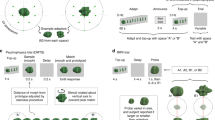Summary
Stimulus patterns, quantized into small squares with the brightness level averaged within each square, were presented for recognition with various exposure durations. Qualitatively different recognition functions were obtained with varying spatial levels of quantization. The method used, if further elaborated, seems appropriate for the empirical differentiation between global and local levels of form and between integration and differentiation stages of a perceptual/attentional process.
Similar content being viewed by others
References
Bachmann, T. (1984). The process of perceptual retouch: Nonspecific afferent activation dynamics in explaining visual masking. Perception & Psychophysics, 35, 69–84.
Breitmeyer, B. G. (1984). Visual masking: An integrative approach. New York: Oxford University Press.
Broadbent, D. E. (1977). The hidden preattentive processes. American Psychologist, 32, 109–118.
Caelli, T., & Yuzyk, J. (1985). What is perceived when two images are combined? Perception, 14, 41–48.
Calis, G., Sterenborg, J., & Maarse, F. (1984). Initial microgenetic steps in single-glance face recognition. Acta Psychologica, 55, 215–230.
Falzett, M., & Lappin, J. S. (1983). Detection of visual forms in space and time. Vision Research, 23, 181–189.
Froehlich, W. D., Smith, G., Draguns, J. G., & Hentschel, U. (Eds.) (1984). Psychological processes in cognition and personality. Washington: Hemisphere.
Garner, W. R. (1974). The processing of information and structure. Hillsdale, NJ: Erlbaum.
Gibson, J. J. (1979). The ecological approach to visual perception. Boston: Houghton Mifflin.
Gubler, E. V. (1978). Computational methods of analysis and recognition of pathological processes (in Russian). Leningrad: Meditsina.
Harmon, L. D., & Julesz, B. (1973). Masking in visual recognition: Effects of two-dimensional filtered noise. Science, 180, 1194–1197.
Harris, C. S. (1980). Visual coding and adaptability. Hillsdale, NJ: Erlbaum.
Johansson, G. (1976). Spatio-temporal differentiation and integration in visual motion perception. Psychological Research, 38, 379–393.
Julesz, B. (1980). Spatial-frequency channels in one-, two-, and three-dimensional vision: Variation on an auditory theme by Bekesy. In C. S. Harris (Ed.), Visual Coding and Adaptability (pp. 263–316). Hillsdale, NJ: Erlbaum.
Julesz, B. (1981). Figure and ground perception in briefly presented isodipole textures. In M. Kubovy & J. R. Pomerantz (Eds.), Perceptual Organization (pp. 27–54). Hillsdale, NJ: Erlbaum.
Kinchla, R. A., & Wolfe, J. (1979). The order of visual processing: “Top-down”, “bottom-up”, or “middle-out”? Perception & Psychophysics, 25, 225–231.
Leeuwenberg, E., Mens, L., & Calis, G. (1985). Knowledge within perception: Masking caused by incompatible interpretation. Acta Psychologica, 59, 91–102.
Lomov, B. F. (1966). Man and machine (in Russian). Moscow: Sovetskoye Radio.
Marr, D. (1982). Vision. San Francisco: Freeman.
Navon, D. (1977). Forest before trees: The precedence of global features in visual perception. Cognitive Psychology, 9, 353–383.
Nikitin, M. P. (1905). On the problem of formation of visual perceptions. An experimental investigation (in Russian). Vestnik psikhologii, kriminal'noy antropologii i gipnotizma, 2, 112–122.
Petersik, J. T. (1978). Possible role of transient and sustained visual mechanisms in the determination of similarity judgments. Perceptual and Motor Skills, 47, 683–698.
Uttal, W. R. (1975). An autocorrelation theory of form detection. Hillsdale, NJ: Erlbaum.
Ward, L. M. (1982). Determinants of attention to local and global features of visual form. Journal of Experimental Psychology: Human Perception and Performance, 8, 562–581.
Werner, H. (1935). Studies on contour: I. Qualitative analyses. American Journal of Psychology, 47, 40–64.
Author information
Authors and Affiliations
Rights and permissions
About this article
Cite this article
Bachmann, T. Different trends in perceptual pattern microgenesis as a function of the spatial range of local brightness averaging. Psychol. Res 49, 107–111 (1987). https://doi.org/10.1007/BF00308675
Received:
Issue Date:
DOI: https://doi.org/10.1007/BF00308675




